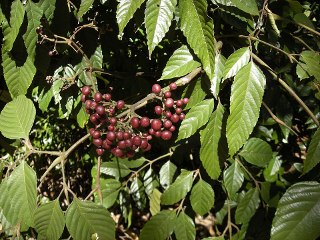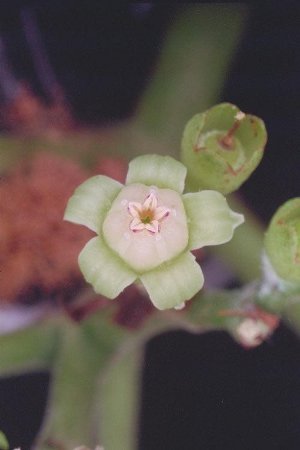Contents:
Common Names | Parts Usually Used | Plant(s) & Culture | Where Found | Medicinal Properties | Biochemical Information
Legends, Myths and Stories | Uses | Formulas or Dosages | Resource Links
Scientific Names

- Leea indica
- Leea novoguineensis
- Leea sambucina Willd.
- Staphylea indica Burm.
- Vitaceae family
Common Names
- Bandicoot Berry
- Chhatri (Sanskrit)
- Hastipalash (Hindi)
- Ki Toowa
- Mali-mali Hanteo
- Soolangkar
Parts Usually Used
Leaves, Fruits, Roots & Shoots
Back to Top
Description of Plant(s) and Culture
Bandicoot Berry is an erect shrub to small tree, often with several stems. It usually grows from 2 – 10 meters tall, occasionally to 16 meters, with stems around 19cm in diameter. Plants are frequently stilt-rooted. The fruit is a purple-black berry 5 – 10mm in diameter, occasionally to 15mm, containing 6 seeds.
Back to Top
Where Found
East Asia – Southern China, Indian subcontinent, through tropical Asia to Australia and SW Pacific
Back to Top
Medicinal Properties

Antimicrobial, antioxidant, cytotoxic, enzyme inhibitory, analgesic, hepatoprotective, hypoglycemic, hypolipidemic, larvicidal, thrombolytic, analgesic, sedative, and antidiarrheal
The root is antidiarrheal, antidysenteric, antispasmodic, cooling, and
sudorific.
Back to Top
Biochemical Information
Phthalic acid, palmitic acid, 1 eicosanol, solanesol, farnesol, three phthalic acid esters, gallic acid, lupeol, β sitosterol, ursolic acid, Alkaloid, terpenoids, flavonoids, steroid, tannin, glycoside, cardiac glycoside, triterpenoid glycosides, quercetin, gallic acid saponins, phenols
Back to Top
Legends, Myths and Stories
Extracts of the fruits are used for purple dye.
Back to Top
Uses
Bandicoot Berry is used to treat fever, eczema, itching, malaria, bone fracture, rheumatism, asthma, diarrhea, dysentery, body ache, hyperdipsia, pruritus, skin injuries, joint pain, colic, head ache, and gastric ulcers.
Bandicoot berry is used to treat intestinal cancer, leucorrhea, and uterus cancer. Drying the leaves allows them to be made into a tea. This tea is used as a treatment for cancer.
An ointment made from roasted leaves is used to relieve vertigo.
Back to Top
Formulas or Dosages
The juice of young leaves is digestive.
Young shoots are chewed to relieve a severe cough.
An ointment or juice made from roasted leaves relieves dizziness or vertigo.
The crushed and pounded leaves are used to make poultices for cuts and skin conditions. It can be placed on the head to treat fever, headache and general body pain.
Make a decoction with the shoots to apply to sores and to treat colic, stomachache, dysentery and diarrhea.
The roots can be used as an ingredient in a treatment against yaws.
Crush the roots and apply as a poultice to treat diarrhea, ringworms, colic and skin sores.
Make a pulp by crushing the root and apply to rashes, stings, allergic skin reactions.
Back to Top
Resource Links
Recent Studies Show Seven Herbs Help Stop Cancer Growth
Australian National Botanic Gardens: Bandicoot Berry
Useful Tropical Plants: Leea indica
Australian Tropical Rainforest Plants: Leea indica
Futurity.org: These Medicinal Plants Put Brakes on Cancer Growth
Semantic Scholar: Traditional uses, chemistry and pharmacological activities of Leea indica
National University of Singapore: Anti-cancer properties uncovered in plants
Back to Top
